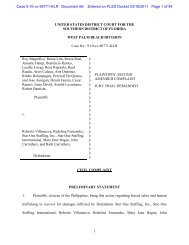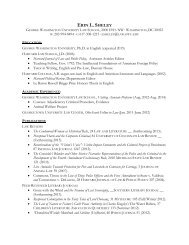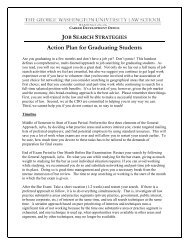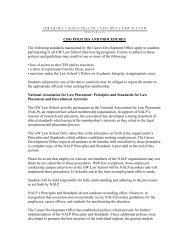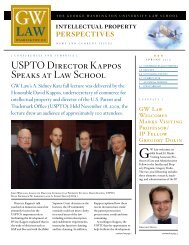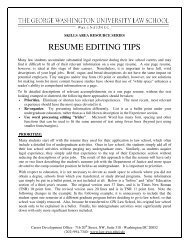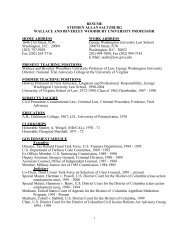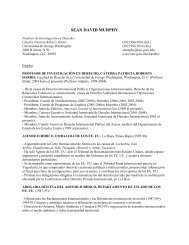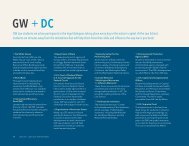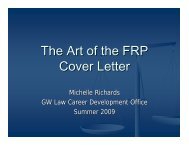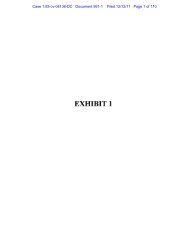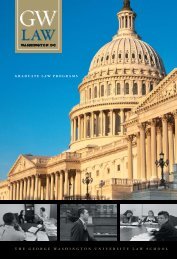CLE Materials for Panel #1 - George Washington University Law ...
CLE Materials for Panel #1 - George Washington University Law ...
CLE Materials for Panel #1 - George Washington University Law ...
You also want an ePaper? Increase the reach of your titles
YUMPU automatically turns print PDFs into web optimized ePapers that Google loves.
WILMARTH<br />
4/1/2011 1:11 PM<br />
2011] The Dodd-Frank Act 1005<br />
such funding, at least some short-term creditors of troubled SIFIs or<br />
SIFI-owned banks are likely to benefit by obtaining full payment of<br />
their claims be<strong>for</strong>e any receivership is created.<br />
Thus, notwithstanding Dodd-Frank’s explicit promise to end<br />
bailouts of TBTF institutions, 224 federal agencies retain several<br />
powers that will permit them to protect creditors of weakened SIFIs.<br />
A more fundamental problem is that Dodd-Frank’s “no bailout”<br />
pledge will not bind future Congresses. When a future Congress<br />
confronts the next systemic financial crisis, that Congress is likely to<br />
abandon Dodd-Frank’s “no bailout” position either explicitly (by<br />
amending or repealing the statute) or implicitly (by looking the other<br />
way while regulators expansively construe their authority to protect<br />
creditors of SIFIs). For example, Congress and President <strong>George</strong><br />
H.W. Bush made “never again” statements when they rescued the<br />
thrift industry with taxpayer funds in 1989, 225 but those statements<br />
did not prevent Congress and President <strong>George</strong> W. Bush from using<br />
public funds to bail out major financial institutions in 2008. As Adam<br />
Levitin has observed,<br />
It is impossible . . . to create a standardized resolution system<br />
that will be rigidly adhered to in a crisis. . . . Any prefixed<br />
resolution regime will be abandoned whenever it cannot provide an<br />
acceptable distributional outcome. In such cases, bailouts are<br />
inevitable.<br />
This reality cannot be escaped by banning bailouts. <strong>Law</strong> is an<br />
insufficient commitment device <strong>for</strong> avoiding bailouts altogether. It<br />
is impossible to produce binding commitment to a preset resolution<br />
process, irrespective of the results. The financial Ulysses cannot be<br />
bound to the mast. . . . Once the ship is foundering, we do not want<br />
Ulysses to be bound to the mast, lest [we] go down with the ship<br />
accompanying text (noting that FHLBs made large advances during 2007 to troubled<br />
LCFIs).<br />
224 See Dodd-Frank Act pmbl.; S. REP.NO. 111-176, at 1 (2010); Kaper, supra note 2.<br />
225 See H.R. REP.NO. 101-54(I), at 310 (1989) (declaring that “Never Again” was “the<br />
theme of the Committee’s deliberations” on legislation to rescue the thrift industry),<br />
reprinted in 1989 U.S.C.C.A.N. 86, 106; <strong>George</strong> Bush, Remarks on Signing the Financial<br />
Institutions Re<strong>for</strong>m, Recovery, and En<strong>for</strong>cement Act of 1989 (Aug. 9, 1989), available at<br />
http://www.presidency.ucsb.edu/ws/index.php?pid=17414#axzz1IIMYLfO9 (statement by<br />
President <strong>George</strong> H.W. Bush that the 1989 thrift rescue statute would “safeguard and<br />
stabilize America’s financial system and put in place permanent re<strong>for</strong>ms so these problems<br />
will never happen again” and that “[n]ever again will America allow any insured<br />
institution to operate normally if owners lack sufficient tangible capital to protect<br />
depositors and taxpayers alike”).




